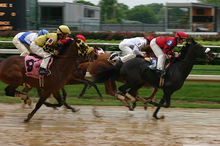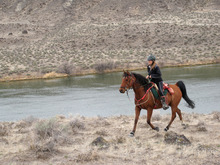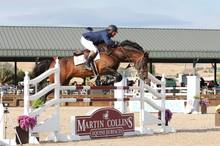There are many opinions regarding what makes a good horse, and various thoughts on what's most important; genetics, structure, attitude/disposition, training, etc, but one of the most crucial aspects is conformation (how the horse's body parts are put together).
Even if a horse has the most popular pedigree in his breed, an amazing personality, and willingness to perform, if he doesn't have the proper structure for his job, whether it's pulling a cart or a sport that requires athletic agility, and for durability, he probably won't be a top performer in the career you choose for him.
Whether you are selecting your first horse or adding another, a careful look at conformation can help guide your choices. First, make sure the horse has the kind of structure that will hold up with continual use and not go lame or become unsound. Secondly you want to choose a horse that can excel in the discipline you enjoy. The most obvious example: a draft horse that is well suited for pulling won't make a good riding horse, and vice versa.

The Agile Sprinter
Stock horses require quick bursts of speed and agility in order to do their job.
© 2012 by Dale A Stork
A gaited horse that is a joy to ride out on the trails for pleasure may not make a very good rope horse or cutting horse. The conformation that enables him to give a smooth, free-flowing extended traveling gait may hinder his ability to collect himself and change direction quickly when chasing cattle in rough terrain or performing reining patterns. A champion reining horse might not make a great jumper and so on. It pays to select a horse with conformation that makes his job easy and won't hinder him in what you want him to do.

The Speed Demon
Race horses are able to carry a high rate of speed over long distances.
© 2013 by Jarrett Campbell
Some horses are built for straight-ahead speed (such as racing), and others are built for more agility and quick changes of direction. Speed horses are also divided into two types - sprinters and distance runners. Horses of what we call stock horse type are generally a little heavier muscled than horses built for long distance speed and endurance.

The Endurance Champion
Endurance horses are built for covering a lot of terrain, at a moderate and non-stop pace.
Many Quarter Horses, Paints, Appaloosas and some Morgans and Arabians are stock horse type and have the quickness to compete successfully in reining, cutting, reined cow horse and other western performance events. When selecting any horse, there are basic points of conformation to keep in mindâfor athletic ability and soundnessâand then some more specific details that may make a difference in how well suited that horse might be to the job you have in mind for him.

The Athletic Leaper
Jumping horses use their hind-end power to leap over amazing obstacles.
© 2013 Martin Collins
A well-built horse can do just about any job reasonably well, if he is well balanced with proper body proportions and joint angles and good legs. For an all-around versatile athlete in a riding horse, look for one with a relatively short back, average length neck (not too long or too short), long and well-sloped shoulder, well-defined withers, deep heart girth and flank, fairly level rump with long quarters, straight front legs, and proper hind leg angles.
Though each breed has some advantages and disadvantages for specific kinds of activity, you can usually find individuals in every breed that have good conformation for all-around versatility.
There will be some that are best suited only for certain activities that the breed tends to specialize in. You will also find some with poor conformation that canât perform or stay sound even in their own discipline, such as Thoroughbred racehorses that canât run fast (or break down trying); Quarter Horses that are not agile enough or fast enough for reining, working cattle, barrel racing or other speed events; Arabians lacking endurance; gaited horses that canât do their gaits; and warmbloods that canât jump or do poorly in dressage.
Even if you have a favorite breed that excels in the discipline you love, you need to be very selective and pay attention to conformation.
Selecting a jumper
Angles on angles
You will often hear horse people talk about "angles". The basic structure of the horse's legs and body have geometric properties that make certain activities easier or harder. Horse breeders select for specific body geometries based on the purpose of the horse.
Good conformation is especially important in a jumper, so he will hold up under the additional stresses of his job. Front legs must be exceptionally strong and correct to withstand the concussion of landing from a jump with all the horse's weight on one front foot. He also needs strong, correct hind leg angles (especially hocks) and hindquarters to give him the power and mobility to jump, and a strong back. If the back is too short there will be more concussion to absorb; if it is too long it will be weak.
He uses his head and neck for balance while jumping, so he needs a relatively long neck (not a short, thick one). He also needs a relatively light front end, but well-made shoulders and front legs because they bear all his weight when landing. The jumper should be wider in the hindquarters than in front; a wide breast would cut down his speed and agility and hinder his jumping ability, making him too heavy in front.
Front legs must have proper angles, to avoid excessive strain on any one joint. Poor front legs increase the risk of injury for the horse and unsafe landings for the rider. Proper angles ensure more agility, and the ability to fold his front legs tightly and raise his knees enough to get over a jumpâwithout having to lift his body so high. A long forearm and short cannon are desirable.
Selecting a stock horse
Activities like cutting, reining, barrel racing, etc. require both speed and agility. To perform well in these disciplines and hold up with hard use, a horse needs good basic conformation (proper angles in body and legs), well-structured joints, and good feet. Hoofs should be adequate size for the size and weight of the body, with strong soles/walls and proper angles.
Western performance horses were originally ranch horses, bred to work cattle all day with speed and agility, and stout enough for roping. Today, however, the traditional stock horse has become a specialist rather than an all-around using horse. A roping horse is generally larger and stouter than a cutting horse.
Todayâs rope horse is generally used only in an arena for short bursts of activity. He must have enough size, power and speed to catch and hold a steer, but is usually too heavy-muscled to have the endurance needed to work cattle all day in rough country. He needs strong hindquarters for quick bursts of speed, but leg structure must also be very correct for agility and quick stops. A good rope horse can break from the box faster than a racehorse breaks from a starting gate.
The cutting horse is probably the most agile and quick of all equine athletes, but todayâs top performers work mostly in an arena under controlled conditions and may not have the durability and endurance of their ranch horse ancestors.
When selecting a cutting or reined cow horse prospect, look for agility and strength, along with the ability and willingness to work cattle. These horses must have the drive and speed to outmaneuver any cow, and the correct leg structure and angles to withstand the stress involved in fast starts, stops, turns and pivots at speed.
The best cutting/cowhorses are relatively small (rarely more than 15 hands in height and often closer to 14 hands). Often the small horse has more quickness and agility than a taller, heavier horse, and can stop and turn more readily.
Reining horses also need proper conformation for speed and agility. These horses must be able to make a smooth stop from a gallop and then pivot and gallop the opposite direction. In competition the horse must be able to do a sliding stop, back up swiftly, do lead changes at the gallop, and spin in small circles, pivoting on one hind leg.
Some reining horse riders prefer a sickle-hocked horse, thinking that having the hind feet farther underneath the body (rather than directly under the hindquarters) helps the horse stop and pivot easier. But if the horse is very sickle-hocked, this puts more strain on the hind legs; the horse is more likely to develop hock problems. The sickle-hocked horse is also less efficient in leg motion (the leg takes longer to straighten at each stride, with wasted motion) and ultimately he is less quick and agile than the more well-balanced individual with proper leg angles.
When selecting any stock horse prospect, remember that the well-conformed individual with proper leg and body angles (no extremes one way or the other) will usually out-perform the horses with less ideal conformation, and will almost always hold up longer without going lame.
Selecting a dressage horse
Dressage requires a horse with good conformation and proper muscle conditioning to perform well. Proper angles in legs and body allow the most freedom of movement and agility, to allow the horse to fully collect and extend his gaits.
A long, well-sloped shoulder (rather than short and upright) is needed for maximum extension of the front legs. A relatively flat or slightly sloped rump and proper angles in stifles and hocks allow the horse to work with his hindquarters well underneath himself for best collection and good impulsion. He needs free-flowing action, with legs moving forward in good straight lines.
A short, strong back enables him to round his back for better collection, and for carrying the weight of a rider. A long back or sway back makes it much harder for the horse to collect himself properly. His back should not be too short, however, or he will be too stiff, without enough flexibility.
Withers should be well defined and fairly long, blending nicely into the back without a hollow behind them. Many dressage riders prefer the horse to be slightly âuphillâ with withers a bit higher than the croup. The hindquarters should never be higher than the withers or too level, or it will be harder for the horse to get his hind legs well underneath himself for proper collection and strong impulsion for advanced dressage movements.
Head and neck conformation and how they hook together is important for proper head carriage and easy collection, so the horse can flex at the poll rather than having the flex point farther down the neck. A horse with a short thick neck or a ewe neck can't flex as readily as the horse with a fairly long and nicely arched neck. Without correct flexion at the poll, a horse canât carry himself (and keep his back properly rounded) for sustained collection.
Selecting an endurance horse
Horses that do best for endurance (whether in competition or for any work that requires many miles per day) are the ones with good heart and lungs and light muscling. Hot-blooded horses (Arabs and Thoroughbreds and their crosses) have more red blood cells and hence more oxygen-carrying capacity which enables them to work longer and harder without fatigue.
A light-muscled horse also has a more efficient cooling system than a heavier-bodied horse with thick muscles. Long, lean muscles can keep working longer, have less trouble getting rid of the waste products from exertion, and are less apt to become sore or âtie upâ after exercise.
To hold up over many miles, however, the horse must also have good conformation in body, feet and legs. His body must be properly proportioned so that all parts work together smoothly. A deep, wide ribcage and heart girth allow for lung room. Legs should be well constructed (straight when viewed from front or rear), with straight action.
Crooked leg action may not matter as much for a pleasure horse that only has to go a few miles each day, but is a major disadvantage in an endurance horse that must go 50 to 100 miles. The extra stress on joints, or occasionally hitting the opposite leg with a hoof may create lameness and unsoundness issues.
Selecting a gaited horse
The gaited breeds have different conformation than other light horse breeds. The gaited horse is often longer in the back, with a short hindquarter and long gaskin. The lumbosacral joint in a gaited horse is always a little farther back, as is the femur placement (toward the rear of the pelvis). The long back has more give and tends to hollowâwhich helps the horse do his gait, with more side-to-side motion and less up-and-down that jars a rider.
The longer tibia helps create a longer overstep with the hind legs. If there is too much distance from stifle to hock, however, with a short femur, the horse will have straight stifles that are prone to patella problems (sticking stifles with the patella catching and sometimes locking).
Some of the common hind leg problems in gaited breeds (in stifles and hocks) can be minimized by avoiding horses with extreme gaited conformation. A good gaited horse is not too long in the back, too sickle-hocked or âcamped out behindâ with hocks too far behind the buttocks. Weak construction has been perpetuated by some breeders who select for the look of the gait rather than sound performance.
First in the series
This is the first in a series of five articles that are written by the author of "The Horse Conformation Handbook
." This book, illustrated by Jo Rissanan (a frequent EquiMed contributor), is a must read for anyone interested in a detailed understanding of horse conformation.


